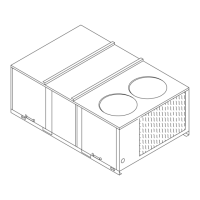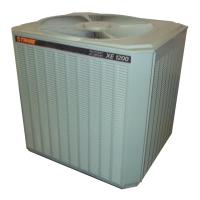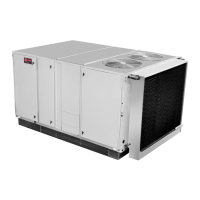RT-SVX23E-EN 23
Installation
Foundation
If the unit is installed at ground level, elevate it above the snow line. Provide concrete footings at
each support location with a “full perimeter” support structure or a slab foundation for support.
Refer to Tab l e 1 , p . 2 1 for the unit’s operating and point loading weights when constructing a
footing foundation.
If anchoring is required, anchor the unit to the slab using hold down bolts or isolators. Isolators
should be installed to minimize the transmission of vibrations into the building.
WARNING
Heavy Unit!
Ensure the roof is strong enough to support the combined unit and support structural weight.
Refer to Ta bl e 1 , p . 2 1 for the unit operating weights.If unsure, contact a structural engineer.
Failure to follow recommendations could result in roof collapsing under the unit’s heavy weight
which could result in death or serious injury and property damage.
For rooftop applications, ensure the roof is strong enough to support the combined unit and
support structural weight. If anchoring is required, anchor the unit to the roof with hold-down bolts
or isolators. Check with a roofing contractor for proper waterproofing.
Ductwork
Figure 14, p. 23 to Figure 19, p. 26 illustrate the supply and return air openings as viewed form the
rear of the unit.
Elbows with turning vanes or splitters are recommended to minimize air noise due to turbulence
and to reduce static pressure.
When attaching the ductwork to the unit, provide a water- tight flexible connector at the unit to
prevent operating sounds from transmitting through the ductwork.
All outdoor ductwork between the unit and the structure should be weather proofed after
installation is completed.
Horizontal Units
Figure 14. Heat pump - 3-4 ton standard efficiency - horizontal airflow supply/return
Note: All dimensions are in inches/millimeters.

